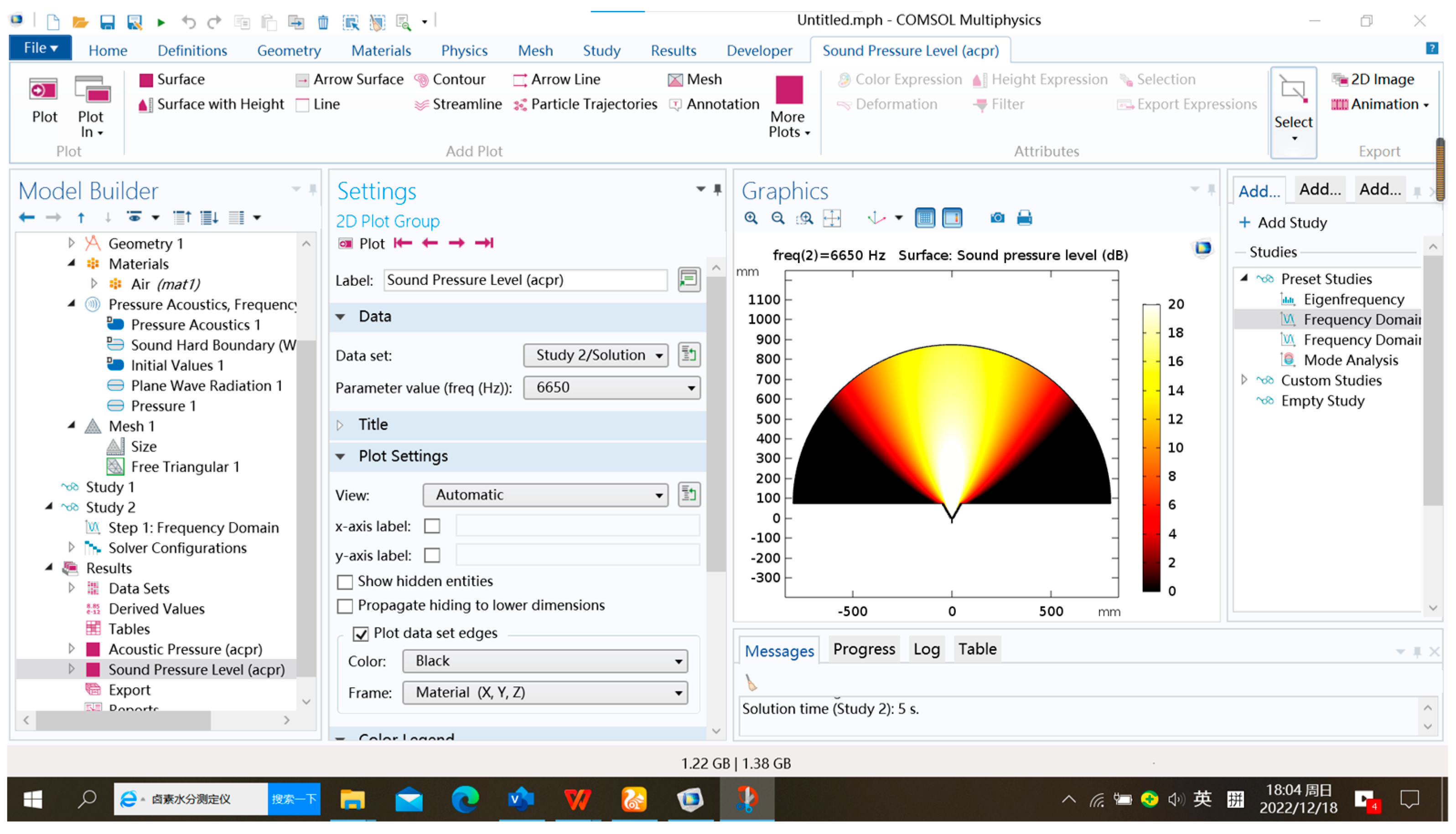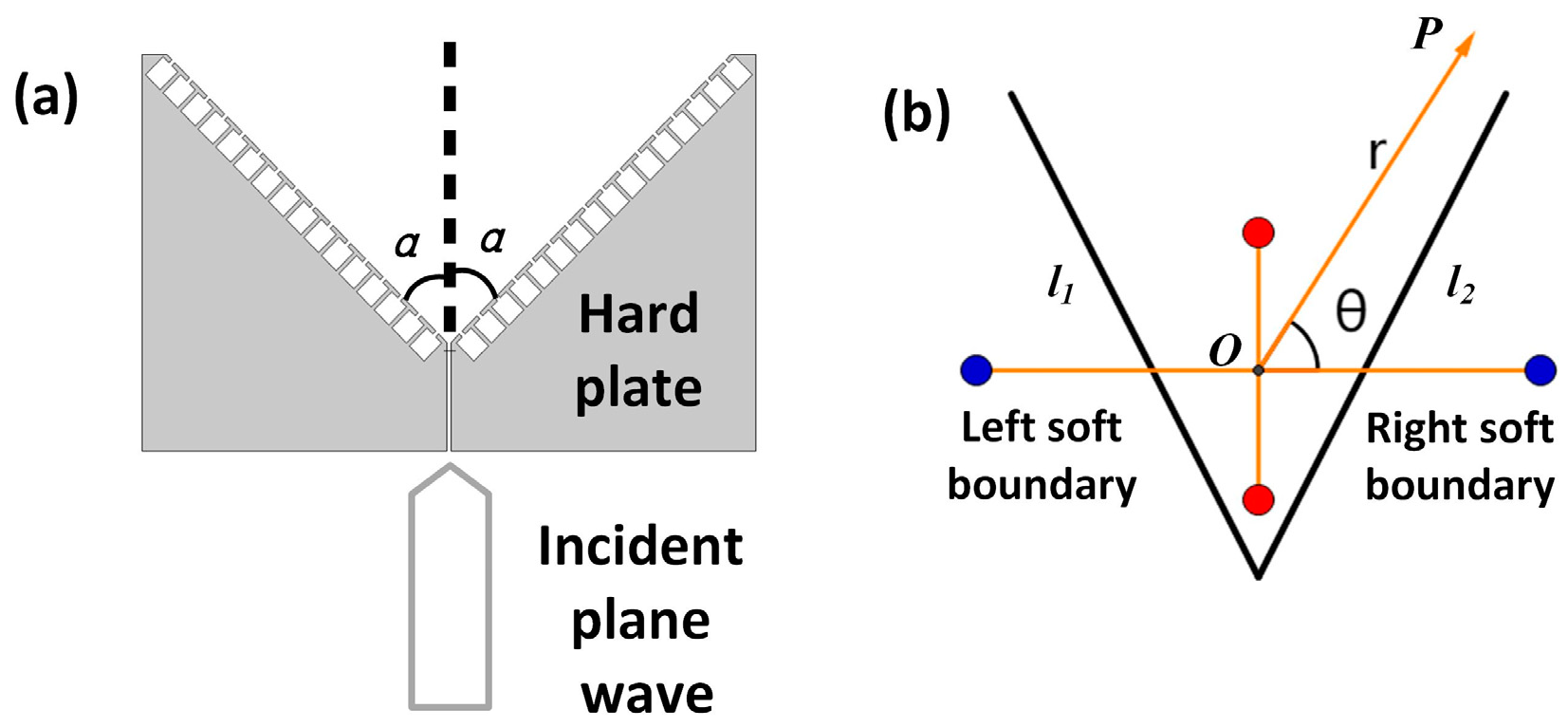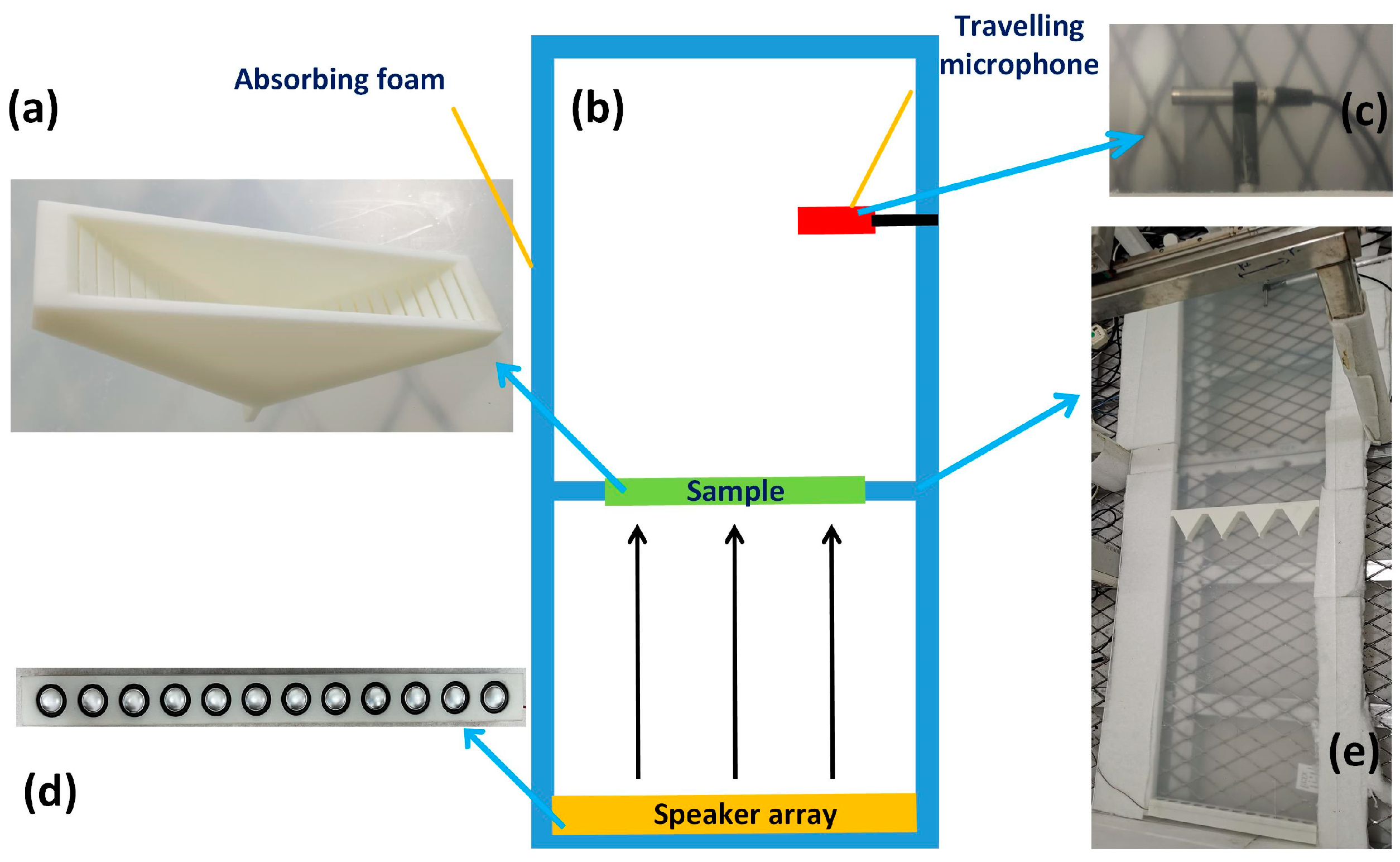Improving the Directionality of Low-Frequency Acoustic Radiation by a Finite Array of Quadrupolar Sources with Acoustic Metamaterials
Abstract
1. Introduction
2. Theoretical Derivation and Verification
2.1. Theoretical Analysis
2.2. Numerical Simulation
2.3. Experimental Results
2.4. Results and Discussion
3. Asymmetric Structure
3.1. Theoretical Analysis
3.2. Numerical Simulation
3.3. Results and Discussion
4. Linear Array of Quadrupole Sources
4.1. Theoretical Analysis
4.2. Numerical Simulation and Experiment
4.3. Comparison between Quadrupole and Dipole Linear Arrays
4.4. Results and Discussion
5. Conclusions
Author Contributions
Funding
Informed Consent Statement
Data Availability Statement
Conflicts of Interest
Appendix A
| Symbol | Meaning | Symbol | Meaning |
|---|---|---|---|
| The density of the medium. | Sound velocity of the medium. | ||
| The acoustic impedance of the structural interface. | The angle of the OP and the horizontal plane. | ||
| The angle between the left and right interfaces of proposed structure. | The distance between each point sound source and point P. | ||
| The velocity potential of each point sound source at the point P. | The total velocity potential at point P (Radiation angle). | ||
| A | The amplitude of the velocity potential of each point sound source. | The wave number of the incident sound. | |
| The angular frequency. | The wavelength. | ||
| The imaginary unit. | The distance between the two positive source. | ||
| The distance from O to P. | The theoretically directivity. | ||
| The angle between the left interface and the central axis of the asymmetric structure. | The angle between the right interface and the central axis of the asymmetric structure. | ||
| f | Frequency of acoustic waves. | Distance between the array units. | |
| m | The number of units on the left of benchmark unit. | n | The number of units on the right of benchmark unit. |

| Instrument | Detailed Information |
|---|---|
| Stepping motor | Made by Nanjing Stepping Motor Factory and the scan accuracy is 1 mm |
| Digital Storage oscilloscope | InfiniiVision DSO-X 3034A |
| Travelling microphone | Beijing AcousticSensing Technology, 1/2″ Microphone.Type:CHZ-213 + YG-201 OPen-circuit Sensitivity Level: −27.6dB re 1 V/pa or 41.6 mV/Pa |
| Speaker array | Particularly custom-made, each unit can make sounds in the range of 20–20,000 Hz |
References
- Perez-Arjona, I.; Sanchez-Morcillo, V.J.; Redondo, J.; Espinosa, V.; Staliunas, K. Theoretical prediction of the non diffractive propagation of sonic waves through periodic acoustic media. Phys. Rev. B 2007, 75, 014304. [Google Scholar] [CrossRef]
- Cebrecos, A.; Rommero-Garcia, V.; Picó, R.; Pérez-Arjona, I.; Espinosa, V.; Sánchez-Morcillo, V.J.; Staliunas, K. Formation of collimated sound beams by three-dimensional sonic crystals. J. Appl. Phys. 2012, 111, 104910. [Google Scholar] [CrossRef]
- Li, B.; Deng, K.; Zhao, H. Acoustic guiding and subwavelength imaging with sharp bending by sonic crystal. Appl. Phys. Lett. 2011, 99, 051908. [Google Scholar] [CrossRef]
- Qiu, C.; Liu, Z. Acoustic directional radiation and enhancement caused by band-edge states of two-dimensional phononic crystals. Appl. Phys. Lett. 2006, 89, 063106. [Google Scholar] [CrossRef]
- Ke, M.; Liu, Z.; Pang, P.; Qiu, C.; Zhao, D.; Peng, S.; Shi, J. Experimental demonstration of directional acoustic radiation based on two-dimensional phononic crystal band edge states. Appl. Phys. Lett. 2007, 90, 083509. [Google Scholar] [CrossRef]
- Soliveres, E.; Espinosa, V.; Perez-Arjona, I.; Sanchez-Morcillo, V.J.; Staliunas, K. Self collimation of ultrasound in a three-dimensional sonic crystal. Appl. Phys. Lett. 2009, 94, 164101. [Google Scholar] [CrossRef]
- Xu, X.; Feng, Y.; Jiang, T. Electromagnetic beam modulation through transformation optical structures. New J. Phys. 2008, 10, 115027. [Google Scholar] [CrossRef]
- Chen, S.; Fan, Y.C.; Fu, Q.H.; Wu, H.J.; Jin, Y.B.; Zheng, J.B.; Zheng, F.L. A Review of Tunable Acoustic Metamaterials. Appl. Sci. 2018, 8, 1480. [Google Scholar] [CrossRef]
- Chen, Q.; Zhang, B.; Bai, Y.; Wang, L.; Rejab, M.R.M. Review of Phononic crystals and acoustic metamaterials. IOP Conf. Ser. Mater. Sci. Eng. 2020, 788, 1757–8981. [Google Scholar] [CrossRef]
- Tong, S.; Ren, C.; Tao, J.; Tang, W. Anisotropic index-near-zero metamaterials for enhanced directional acoustic emission. J. Phys. D 2020, 53, 265102. [Google Scholar] [CrossRef]
- Tao, J.; Tong, S.; Ren, C. Anisotropic density-near-zero metamaterials for enhanced directional and aperture-adjustable acoustic emission. J. Phys. D 2021, 54, 485102. [Google Scholar] [CrossRef]
- Tong, S.; Ren, C.; Tao, J. Compact topological waveguide for acoustic enhanced directional radiation. Appl. Phys. Lett. 2022, 120, 063504. [Google Scholar] [CrossRef]
- Quan, L.; Zhong, X.; Liu, X.; Gong, X.; Johnson, P.A. Effective impedance boundary optimization and its contribution to dipole radiation and radiation pattern control. Nat. Commun. 2014, 5, 3188. [Google Scholar] [CrossRef] [PubMed]
- Wilson, G.P.; Sorka, W.W. Approximation to the diffraction of sound by a circular aperture in a rigid wall of finite thickness. J. Acoust. Soc. Am. 1965, 37, 286–297. [Google Scholar] [CrossRef]
- Ciaburro, G.; Lannace, G. Membrane-type acoustic metamaterial using cork sheets and attached masses based on reused materials. Appl. Acoust. 2022, 189, 070206. [Google Scholar] [CrossRef]
- Lobanov, S.V.; Weiss, T.; Dregely, D.; Giessen, H.; Gippius, N.A.; Tikhodeev, S.G. Emission properties of an oscillating point dipole from a gold Yagi-Udanano antenna array. Phys. Rev. B 2012, 85, 155137. [Google Scholar] [CrossRef]
- Ding, E.; Mao, Y.; Liu, X. Realizing a finite array of dipole sources with high acoustic transmission directivity at low frequency. J. Acoust. Soc. Am. 2017, 1413, 1936–1939. [Google Scholar] [CrossRef] [PubMed]
- Zhou, Y.; Lu, M.-H.; Feng, L.; Ni, X.; Chen, Y.-F.; Zhu, Y.-Y.; Zhu, S.-N.; Ming, N.-B. Acoustic surface evanescent wave and its dominant contribution to extraordinary acoustic transmission and collimation of sound. Phys. Rev. Lett. 2010, 104, 164301. [Google Scholar] [CrossRef] [PubMed]







| Structural Types | Material | Width (mm) | Height (mm) | Thickness (mm) | Slit Width (mm) | Slit Length (mm) |
|---|---|---|---|---|---|---|
| resin | 104 | 99 | 34 | 2 | 25 | |
| resin | 132 | 87 | 34 | 2 | 25 | |
| resin | 164 | 68 | 34 | 2 | 25 |
Disclaimer/Publisher’s Note: The statements, opinions and data contained in all publications are solely those of the individual author(s) and contributor(s) and not of MDPI and/or the editor(s). MDPI and/or the editor(s) disclaim responsibility for any injury to people or property resulting from any ideas, methods, instructions or products referred to in the content. |
© 2023 by the authors. Licensee MDPI, Basel, Switzerland. This article is an open access article distributed under the terms and conditions of the Creative Commons Attribution (CC BY) license (https://creativecommons.org/licenses/by/4.0/).
Share and Cite
Zeng, Q.; Gao, S.; Lai, Y.; Liu, X. Improving the Directionality of Low-Frequency Acoustic Radiation by a Finite Array of Quadrupolar Sources with Acoustic Metamaterials. Crystals 2023, 13, 101. https://doi.org/10.3390/cryst13010101
Zeng Q, Gao S, Lai Y, Liu X. Improving the Directionality of Low-Frequency Acoustic Radiation by a Finite Array of Quadrupolar Sources with Acoustic Metamaterials. Crystals. 2023; 13(1):101. https://doi.org/10.3390/cryst13010101
Chicago/Turabian StyleZeng, Qinglei, Shenlian Gao, Yun Lai, and Xiaozhou Liu. 2023. "Improving the Directionality of Low-Frequency Acoustic Radiation by a Finite Array of Quadrupolar Sources with Acoustic Metamaterials" Crystals 13, no. 1: 101. https://doi.org/10.3390/cryst13010101
APA StyleZeng, Q., Gao, S., Lai, Y., & Liu, X. (2023). Improving the Directionality of Low-Frequency Acoustic Radiation by a Finite Array of Quadrupolar Sources with Acoustic Metamaterials. Crystals, 13(1), 101. https://doi.org/10.3390/cryst13010101








